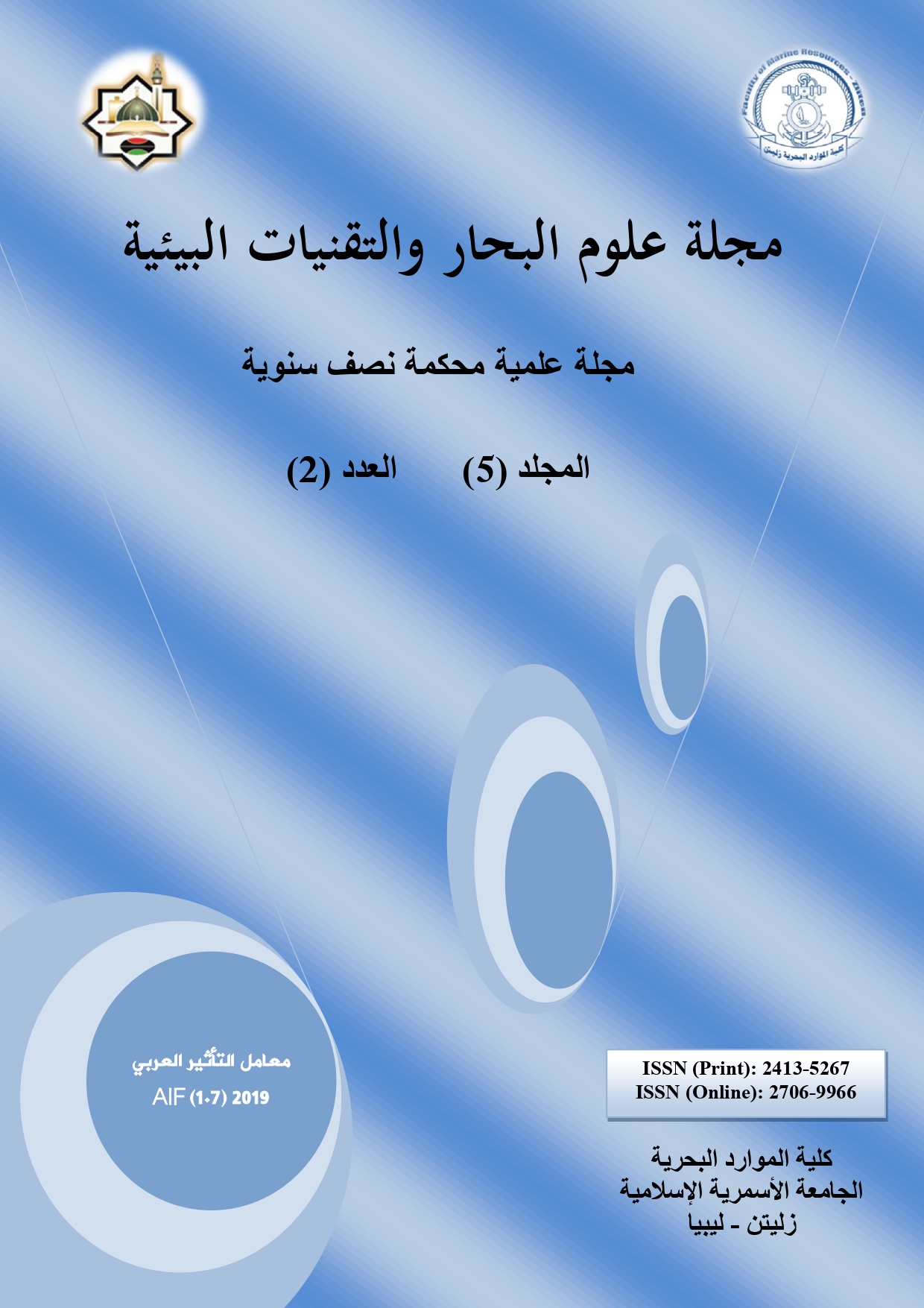تحسين لون زيت مخلفات اسماك الكارب Cyprinus carpio المستخلص بالأشعة تحت الحمراء بطريقة سطح الاستجابة
DOI:
https://doi.org/10.59743/jmset.v5i2.60الكلمات المفتاحية:
زيت السمك، برنامج Image processing، مخلفات سمك الكارب، لون الزيت، الأشعة تحت الحمراءالملخص
تم استخلاص زيت مخلفات سمك الكارب (Common carp (Cyprinus carpio بواسطة جهاز يعمل بالأشعة تحت الحمراء وان الهدف من هذه الدراسة هو قياس احد الصفات الحسية المهمة وهي صفة اللون بطريقة معالجة الصور Image processing وتضمنت هذه الصفة المهمة دراسة عدة مؤشرات لها وهي درجة الوضوح L*، درجة الاحمرار/الاخضرار *a، درجة الاصفرار/الازرقاق *b، زاوية اللون h. اجريت عملية التحسين بطريقة سطح الاستجابة باستخدام التصميم المركب المركزي من اجل تحديد الظروف المثلى للحصول على افضل صفات اللون للزيت المستخلص، واستخدمت معادلات الانحدار المتعدد اللاخطي إذ انه من خلالها يمكن التنبؤ بقيم صفات اللون. اظهرت النتائج ان اعلى قيم عملية ومتنبأ بها لدرجة الوضوح، درجة الاحمرار/الاخضرار، درجة الاصفرار/الزرقة، زاوية اللون هي 62.53، 39.15، 0.94، 1.12، 50.82، 33.89، 1.15، 0.096 على التوالي. اظهرت نتائج التحليل الاحصائي وجود تأثير معنوي (P<0.05) لدرجة الحرارة، القدرة، المسافة والتداخلات فيما بينها في *a، بينما لم تتأثر معنويا كل من *L و *b و h بتلك المعاملات. وقد أظهرت نتائج التحسين ان الظروف المثلى كانت 66.14 مئوي، 215.94 واط، 24.02 سم لكل من درجة الحرارة والقدرة والمسافة على التوالي.
المراجع
قائمة المراجع باللغة العربية:
المطوري، أثير عبد الامير عبد الجبار (2019). دراسة كفاءة استخلاص زيت مخلفات الاسماك باستعمال جهاز مصمم محليا يعمل بالأشعة تحت الحمراء. رسالة ماجستير، قسم علوم الاغذية، كلية الزراعة، جامعة البصرة، العراق.
المطوري، أثير عبد الامير عبد الجبار؛ الشطي، صباح مالك حبيب؛ والحلفي، أسعد رحمان سعيد (2018). تأثير نوع العبوة على بعض الدلائل الكيميائية لزيت مخلفات اسماك الكارب Cyprinus carpio المستخلص بالأشعة تحت الحمراء. مجلة علوم البحار والتقنيات البيئية، 4(2): 1-16.
قائمة المراجع باللغة الإنجليزية:
Al-Hilphy A.R.S. (2017). Food processing engineering by using infrared ray. Noor Publishing, Germany.
Abdullah M.Z., Guan L.C., Lim K.C., and Karim A.A. (2004). The applications of computer vision and tomographic radar imaging for assessing physical properties of food. Journal of Food Engineering,61(1): 125-135.
Ayala- Silva T., Schnell R.J., Meerow A.W., Winterstein M., Cervantes C., and Brown J.S. (2005). Determination of color and fruit traits of half-sib families of mango (Magnifera indica L.). Proceedings of the Florida State Horticultural Society, 118: 253-257.
Costa C., Antonucci F., Pallottino F., Aguzzi J., Sun D., and Menesatti P. (2011). Shape analysis of agricultural products: A review of recent research advances and potential application to computer vision. Food and Bioprocess Technology, 4(5): 673–692.
Du C., and Sun D. (2004). Recent developments in the applications of image processing techniques for food quality evaluation. Trends in Food Science and Technology, 15(5): 230-249.
Gulrajani M.L. (2010). Color measurement principles advances and industrial applications. Woodhead Publishing Limited, Cambridge, UK.
Hatcher D.W., Symons S.J., and Manivannan U. (2004). Developments in the use of image analysis for the assessment of oriental noodle appearance and color. Journal of Food Engineering, 61(1): 109-117.
Latscha T. (1989). The role of astaxanthin in shrimp pigmentation. Advances in Tropical Aquaculture, Workshop at Tahiti, French Polynesia, 20 Feb - 4 Mar 1989, Actes de colloques Ifremer, Tahiti, French Polynesia, 20 Feb-4 Mar 1989, n°9, chap. 31, pp: 319-325.
Leon K., Mery D., Pedreschi F., and Leon J. (2006). Color measurement in L* a* b* units from RGB digital images. Food Research International, 39(10): 1084–1091.
McGuire R.G. (1992). Reporting of objective colour measurements. Horticultural Science, 27(12): 1254-1255.
Papadakis S.E., Abdul-Malek S., Kamdem R.E., and Yam K.L. (2000). A versatile and inexpensive technique for measuring color of foods. Food Technology, 54(12): 48-51.
Pathare P.B., Opara U.L., and Al-Said F.A. (2012). Colour measurement and analysis in fresh and processed foods: A review. Food and Bioprocess Technology, 6(1): 36-60.
Pedisic S., Levaj B., Dragovic-Uzelac V., Skevin D., and Skendrovic-Babo M. (2009). Color parameters and total anthocyanins of sour cherries (Prunus cerasus L.) during ripening. Agriculturae Conspectus Scientificus, 74 (3):259-262.
Pedreschi F., Aguilera J.M., and Brown C.A. (2000). Characterization of food surfaces using scale-sensitive fractal analysis. Journal of Food Process Engineering, 23(2): 127-143.
Sahin S., and Sumnu S.G. (2006). Physical properties of foods. Springer Science Business Media, LLC. USA.
Segnini S., Dejmek P., and Öste R. (1999). A low cost video technique for colour measurement of potato chips. Lebensmittel-Wissenschaft und Technologie, 32(4): 216–222.
Voss D.H. (1992). Relating colorimeter measurement of plant color to the royal horticultural society colour chart. Horticultural Science, 27(12): 1256–1260.
Yam K.L., and Papadakis S. (2004). A simple digital imaging method for measuring and analyzing color of food surfaces. Journal of Food Engineering, 61(1): 137-142.
التنزيلات
منشور
إصدار
القسم
الرخصة
الحقوق الفكرية (c) 2019 مجلة علوم البحار والتقنيات البيئية

هذا العمل مرخص بموجب Creative Commons Attribution 4.0 International License.









